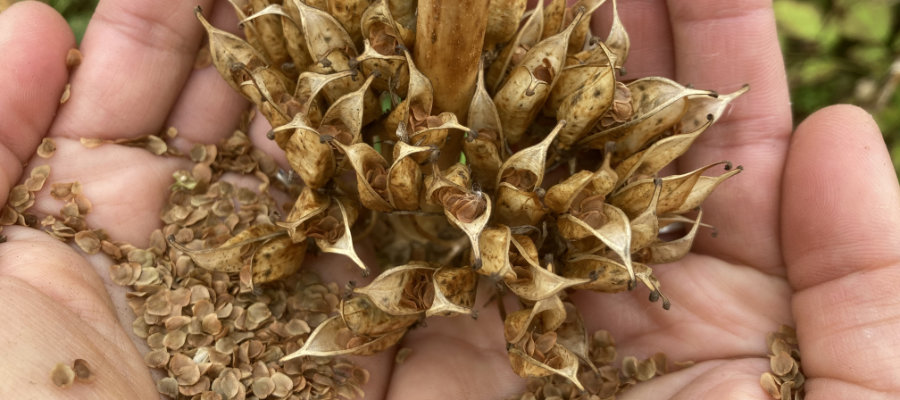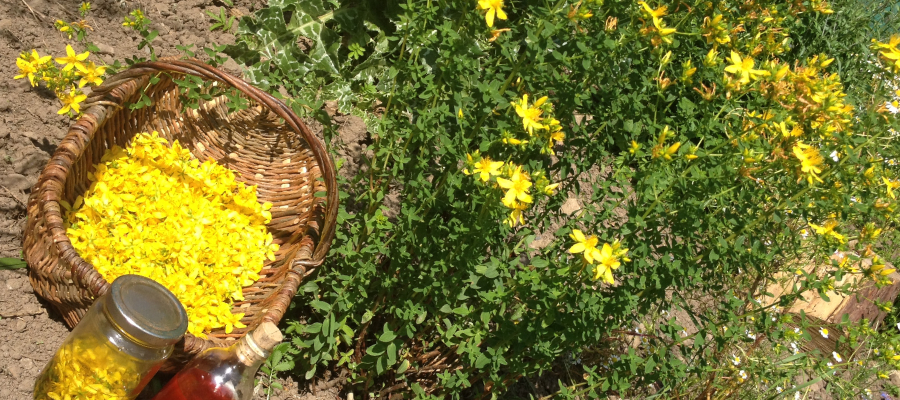As the growing season begins to fold inward on the approach of the Autumnal Equinox it always brings that big shift in the energies of the plants and a welcome exhale from ourselves. Equinox happens to be the anniversary of the day we moved our plants and young family to Ivywood and now to add to this commemorative time it is our third baby Ivara’s birthday. Yes, September 21st is a special time of reflection and gratitude for us in the gardens and the home.
In the weeks coming up to equinox we are finishing off our seed saving around the gardens and completing the last of this year’s potting on of baby seedlings in the herb nursery. Our attention will then move into the forest as we prepare to harvest our woodland medicinal root crops.
There are many plants in the gardens that require you to save seed anytime from midsummer. These early seeders such as Angelica archangelica, Lactuca spp., Echium vulgare, Astragalus membranaceus, Pulsatilla vulgaris and Gentiana spp. need to be watched closely over the late summer months for seed forming. As soon as the seeds are falling freely from heads or the pods are fat, they are collected and sown straight away to give you the best germination rates.
We prefer to sow these freshly formed seeds in trays or pots as soon as possible to ensure strong new baby plants for early spring. These little seedlings are left outside over the winter months. They can then be potted on as they begin to emerge in February for the nursery or planted out in our garden and crop beds.
For later seed savings done after the autumnal equinox we always advise to wait until late spring to sow. Throughout the winter months carefully drying and storing your seed is essential work. For any herbalist wishing to grow their own plants, whether to supply their clinical practice or for a herb garden, understanding best seed saving and storing practices is crucial.
Many herbal seeds such as that of Cimicifuga racemosa require stratification of warm, cold and a second warm period over three months to germinate. This type of seed saving, and sowing is individual to the plant but once learnt it’s just a matter of incorporating it into your winter herb growing routine.
After equinox Ross and I will survey which root plants we will harvest this year and make a plan. We know all the plants grown at Ivywood intimately. Always being mindful of whom has really thrived over the last season, any health issues a plant may have encountered and of course their individual age. Even when growing on a commercial scale this ongoing observation of the plants is hugely important work. For many root crops we have tended them patiently for 4-5 years before planning to harvest often checking on the health of their roots each season.
In our experience it is vital we get our autumn root harvest done before any rainy winter weather. Damp winters here in Ireland mean that certain roots are susceptible to rot if left until January to harvest. This is especially so for garden root medicinals such as Angelica sinensis, Platycodon grandiflorus, Salvia miltiorrhiza, Scutellaria biacalensis and Codonopsis pilosula.
If you miss them in autumn, it’s not a problem as they should return next year. If you had been hoping to harvest for drying or tincturing for your own clinic missing their harvest may mean not having that herb available for your patients for a whole year. Managing your own clinic supply of herbs necessitates devoting time observing and in the company of your plants.
Even in well drained soils a very rainy winter can have a devastating effect your root herbs. This comparison of freshly dug Symphytum roots pictured shows a waterlogged root and a healthy root. The waterlogged root is of course to be discarded. However, plants such as Inula helenium, Amoracia rusticana, Althea off., Arctium lappa, Echinacea spp. and Astragalus membranaceus can tolerate the damp winter ground. You may notice over the years parts of roots of your Valeriana and Inula will naturally rot away. This is nothing to worry about, many plants need to do this as part of their regrowth.
For Astragalus we collect seed and sow straight away in early August. They are so susceptible to slugs that we have found keeping the seedlings inside for the first year and then planting out in their second spring is the best way to ensure their survival and chance of becoming strong with a better root spread. They will then be harvested in autumn after another 2-3 years. Astragalus is one plant we always like to have a steady supply of for our clinical practice. We sow and plant out this herb in new beds every year. As it’s a Leguminosae family plant we always rotate it to replenish soils.
There are many medicinal root crops like Glycyrrhiza glabra/ uralensis, Polygonum multiflorum and Withania somnifera we prefer to grow under cover. Although Withania is a perennial, when cultivating it as an outside crop it is best to harvest roots at the end of its first year. We sow in early February, pot on to keep indoors till late frosts pass, then plant out in May to harvest early November before any heavy rains. For a Withania crop grown inside polytunnels or glasshouses we always wait to harvest in its second year around the time it just dies back. It’s worth noting that with any Solanaceae medicinals like Withania somnifera, Datura stramonium, and Atropa belladonna they like a nitrogen rich soil so require rotation for healthy growth.
Our woodland medicinal root crops need to be tended to in several ways. These root medicinals include Hydrastis canadensis, Sanguinaria canadensis, Eleuthrococcus senticosus, and Dioscorea villosa.
In the past we created a woodland setting under shade tunnels to cultivate these herbs commercially. We gathered and scattered leaf mould from under trees to over winter the crops. Since moving our plants from our farm to our woodland we can now grow them directly under woodland cover. This shift in learning has taken a lot of trial and error planting in various areas of our woodland over the last 4 years.
Last winter we ended up moving a large crop of Sanguinaria from under 20 year old Oak trees. We found that the hungry young, fast-growing trees were taking up so much nutrients leaving the Sanguinaria struggling to thrive. We noticed they also found it a little too dark so we decided to move them to raised beds under an area of Sycamore and Beech trees on the edge of another part of the woodlands.
The age of the woodland will have a marked effect on forest floor medicinals. In the ancient parts of the Ivywood woodland the light is too dark most of the year round. This however is ideal for medicinal plants like Ficaria verna and Ajuga reptans which naturally make their homes in those spaces over years.
We had similar trials with our Hydrastis canadensis crops. So much so that over the last number of years we have had to hold back on selling this much sought-after plant from our nursery. Each time we harvest this valuable root crop we carefully divide and replant back in 20 baby rootlets to replace the one plant we harvested. All our Hydrastis harvesting is done away from sunlight to ensure no degrading of the phytochemicals. For crops like Hydrastis, we always collect and cover with the most appropriate leaf mould regardless of where in the woodland we have planted it. We have found that Beech and Sycamore leaves are too durable and therefor deteriorate too slowly to provide nourishment the plants. Whereas we find leaf mould of Oak is most ideal.
People often ask us about how we ensure our woodland plants don’t ‘take over’ the place. There is a lot of nurturing and tending involved in growing these plants which includes ensuring they have space from encroaching brambles, not letting them get saturated in damp soil or equally too dry soil under the trees, examining their root spread each season, and protecting their tender shoots from being eaten by little shrews or deer.
As with all the medicinals we grow we feel a responsibility to respect the environment we are in whilst being aware of the importance of having these plants available for other herbalists and plant lovers to grow and cultivate. A significant part of our work and our passion as herbalists is to encourage others to create their own sustainable supply of medicines. We are also aware that a deeper personal healing journey is naturally embarked upon by those given the opportunity to nurture and devote time to these amazing plants. As multidisciplinary herbalists ourselves we love to grow and get to know medicinal plants from the Chinese Medicine, Ayurvedic, North and South American and African herbal traditions alongside herbs which are commonly considered here as ‘western’ herbal medicine plants.
As autumn equinox rolls in, we look forward to closing the doors of the herb nursery for the year and to the beckoning in of that gentler grounding sense that slowly seeps into ourselves and the plants. In our reflections for the season, we are grateful for the connections with fellow plant lovers, and we hope that they will continue to be moved to explore deeper relationships with the plants they tend.













